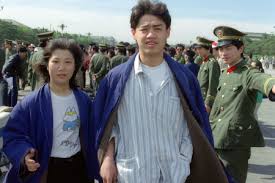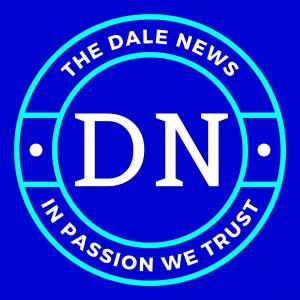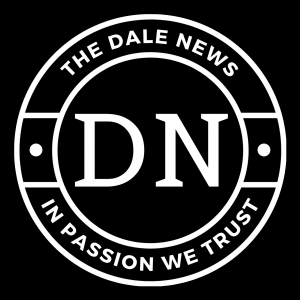-
The Hidden Truths and Public Myths of the Tiananmen Massacre

Editor’s Note:
After last summer’s protests upended the United States, it is important to look at the way civil protests can quickly devolve into chaos and how distorted the details of those chaotic events can be reported in the mainstream media. Farmingdale student Chris Kosel’s report on the media coverage of the events that took place over 30 years ago in 1989 in Beijing, China is enlightening on multiple levels. There are lessons to be learned from his article for those of us approaching the summer of 2021 about the dynamic and sometimes unknowable perspectives and motivations of the reporters, the story-tellers, the witnesses, and the narrators of the events that shift history. Please read Chris’ report below:
The Tiananmen Square Massacre shook the world in the summer of 1989 as foreign nations watched Chinese citizens protest the strict regime they lived under. The city of Beijing was locked in conflict between a military force and the citizens challenging the governmental regime. As history was written, the Chinese government attempted to fabricate their own timeline of events and wipe information from the history books hoping the world would forget. The world’s immediate reaction to Chinese government’s reports of the Tiananmen Square Massacre was that the Chinese government falsified and fabricated information. However, this is only partially true. Inaccuracies and myths surrounding the Tiananmen Square Massacre also exist within the stories and reports of journalists present during the citywide feuds. Truthfully, despite the fact that many people around the globe have historically believed that the Chinese government was the sole perpetrator of the spreading of false information, the source of many myths surrounding the massacre actually come from the stories and reports of journalists present in the city. On the other side of the coin, however, journalists also provided the world with some of the few reliable windows that exist into what happened during the massacre. They did this by interviewing people who actually lived through it and sharing their stories.
Tiananmen Timeline
April 15, 1989:
The events of Tiananmen Square as they are known in history did not occur over the hours of a single night, but rather across multiple weeks. The beginning of this series of events can be traced back to April 15, 1989, when Hu Yaobang, the chief of the Chinese Communist Party and a leading reformist, died of a heart attack. This led hundreds, and later thousands, to gather in Beijing’s Tiananmen Square to mourn Hu Yaobang as well as express their dissatisfaction with the minimal actions of reform in China on behalf of the people. In mere days, the people in Beijing numbered in the thousands and demonstrations and protests spread to universities and neighboring cities. Hu Yaobang’s memorial service was held on April 22nd, and thousands of students came together outside of the Great Hall of People in Tiananmen Square to mourn in spite of earlier warnings by the government that protesters would be punished. The protesters delivered a petition of demands for reform in China and insisted upon a meeting with China’s premier, or prime minister, Li Peng, which was rejected.
April 28, 1989:
At the end of April 1989, the state-run newspaper, the People’s Daily, put out a harsh editorial slandering the protesters in Tiananmen and Beijing, accusing the protesters of rejecting the Communist Party. This piece only fueled the ever-increasing public anger. Tens of thousands of Chinese students stage a massive pro-democracy demonstration beginning on May 4th across at least five cities including Beijing.
May 13, 1989:
Later on, on May 13th, many of the protesters in Tiananmen Square began a hunger strike pushing for political reforms in China, blaming the drastic measures they took on the government’s ineptitude towards change, reform, and denial of a discourse between them and the people. This bold move drew a massive public support for the cause of a democratic, reformed China and also coincided with a planned visit from Mikhail Gorbachev, the Soviet Leader at the time. On May 15th, Gorbachev arrived in Beijing for the first Sino-Soviet summit in 30 years with the intention of formally ending decades of aggression between the two nations. The protests forced the government’s hand and they were unable to welcome Gorbachev in Tiananmen Square as they had planned, reflecting poorly on them and concluding as a sizable embarrassment on their behalf.
May 19, 1989:
On May 19th, Zhao Ziyang, a high-ranking official within the People’s Republic of China, or the Chinese governmental body, and the third premier of China ahead of Li Peng, visited the students in the Square in an unsuccessful last ditch effort to reach an agreement with them. With this attempt bearing no fruit, troops began to move into districts across Beijing as martial law was declared the next day. On June 2nd, the Communist Party elders approved a decision to neutralize the ‘counter-revolutionary riot’ by force. At this command, thousands of PLA soldiers began to move towards the city center as people gathered en masse to halt their march, barricading the streets that lead to Tiananmen Square once again. In these final days, protesters were given one final chance to cease their actions and leave the square peacefully. Some took this option but a majority of them stood their ground. The army broke through the barricades on June 3rd in their armored personnel carriers as troops opened fire into groups of unarmed civilians, killing and wounding some in the process.
June 4, 1989:
On June 4th, the nation woke up in a state of shock with blood staining the streets of Beijing. Angry residents of the city swarmed the north-east entrance into Tiananmen Square only to be met with a blockade of soldiers who open fire once again as they had the night before with the sound of gunfire peppering the air throughout the day. The government praises the military intervention as a great victory, with editorials published in favor of them “severely and mercilessly punishing the ‘lawless people who plan riots and disturb social order’” (“Timeline: Tiananmen Protests”). In an act of defiance, Peking Radio’s English language service condemned the actions of the military, reporting death tolls in the thousands and calling out the government on their brutality against their own civilians. The government attempted to claim no one was officially killed in the square itself, with much of the information surrounding this being muddled.
June 9, 1989:
On June 9th, China’s Leader, Deng Xiaoping, makes his first appearance since the Tiananmen Square Massacre praising the actions of the military and blaming the conflict on the protesters claiming they “wanted nothing less than to overthrow communism” (“Timeline: Tiananmen Protests”).
This is the narrative presented and taken as fact by the Western world. While the majority of the chronology of these events hold water, certain aspects of the events across Beijing and within Tiananmen Square were fabricated and continue to be accepted as truth decades after the initial events.
Tank Man
The infamous “Tank Man” event, and subsequent photograph, occurred on June 5th, when a lone businessman blocked the path of a column of tanks moving through the streets of Beijing that the military had regained control of. His blocking of the tanks was filmed and shared internationally. It is unknown what happened to him after his brave stance. There are images showing him getting dragged away by two figures in blue and vanishing into the crowd. Some stories report that he was executed a couple of weeks after the incident, while other stories maintain that he is still alive. His fate remains unknown to this day.
Tiananmen Cover Up and Falsification of Events
There is no doubt that the cover up of the Tiananmen Square Massacre was initially perpetrated by the Chinese government. While this has been proven since the events of June 3rd and 4th of 1989, the extent of the cover up has been a topic of debate for decades. The majority of the myths stemming from the Tiananmen Square Massacre actually trace their sources back to Western journalists who fabricated a narrative surrounding the events of June 4, 1989, after the square was fully cleared of protestors and civilians. The Western journalists produced the narrative that all of the violence occurred in Tiananmen Square and nowhere else in Beijing. They reported that it was only in Tiananmen Square itself where protestors were gunned down by the hundreds and thousands as they clashed and attempted to flee. This narrative is what western news outlets fabricated in order to push their foreign, pro-democracy agenda that their audiences accepted as fact. This fabricated narrative is backed up with false eyewitness events from the journalists who were in no position to actually view the square and any actions that occurred. The narrative was widely accepted by the audiences of these news outlets, and eventually buried the truth of what occurred in the time leading up to, and the actual occurrence of, the tragedy at Tiananmen Square and its surrounding areas. By the time they attempted to correct the narrative and fabrications, it was too late, as the public’s general opinion regarding the event was shaped by lies as the false narrative dominated Western thought.
Jay Mathews, the Washington Post’s Bureau Chief in Beijing at the time of the Tiananmen Square events in 1989, wrote in an article in 1998 where he wrote that, “‘Most of the hundreds of foreign journalists that night, including me, were in other parts of the city or were removed from the square so that they could not witness the final chapter of the student story. Those who tried to remain close filed dramatic accounts that, in some cases, buttressed the myth of a student massacre” (Becker). Reporters watching from different locations, such as the Beijing Hotel, claimed to see soldiers shooting at students at the monument present in the center of the square, however, the center of the square was not visible from their vantage point of a high up hotel room.
The problem with the journalists’ dramatic narratives are that, according to historical evidence, they don’t align with eyewitness accounts that don’t corroborate that many people died in Tiananmen Square that night. All verified eyewitness accounts “say that the students who remained in the square when troops arrived were allowed to leave peacefully” (Mathews). Mathews further backs up the fact that the focal point of the protests and clashes being in Tiananmen Square was a ruse fabricated by media outlets that has been regarded as the truth for decades. In addition, students and protestors were given chances to leave peacefully and they accepted the invitation to leave by the thousands. Further corroborating the fact that Tiananmen Square was not the actual site of much violence were leaks by Julian Assange, the creator of Wikileaks. He published that “cables confirmed that most of the deaths happened in clashes between the demonstrators and the military in different parts of the city and not in the square” (Rahman). While the location and severity of the clashes have been debated for decades, there is no doubt that the Chinese military took drastic action against civilians. The fabricated accounts published by Western journalists make it hard to believe any information coming from anything other than the mouths of those who lived through the events and did not simply watch them occur from the relative safety of far-away vantage points.
Firsthand Accounts
Li Xiaoming, who was a radio operator in the People’s Liberation Army in 1989. He was tasked with cleaning up Tiananmen Square on the morning of June 5th and “found blood and trousers with bullet holes in the rubbish bins” (Needham). He claimed that the orders to use force against protestors came from high up in the chain of command. Li’s commander received the orders to move to the square hastily; however, he sympathized with the protesters, making their decision to treat them as hostile a conflicting and difficult one for him. They arrived on June 5th, “and Li believes the blood he saw in the square is evidence that some people were killed there” (Needham). Soldiers were told if students got within 100 meters they should fire at the sky, the ground if they were within 30 meters, and they could fire at them should they have come any closer than that.
While clashes occurred in Tiananmen Square, this was not the only location of them. Many different locations in the surrounding areas of the square, and Beijing overall, saw conflict between protestors and soldiers put in place to maintain order. In fact, Historian Wu Ren-hua’s research on the topic shows that “100 hospitals received patients who were shot or killed that night, and there were 90 sites across Beijing where troops opened fire on people” (Needham). Wu Ren-hua’s research further disproves the journalists’ perspectives that the majority of fighting occurred within the square itself, as multiple hospitals across the greater Beijing area received patients with gunshot wounds who were either dead or wounded.
More truths are revealed from those who were in the square and surrounding areas during the peak of the conflict. One such example is that of Fang Zheng, a 20 year old student at the time. He lost both of his legs when a tank column ran him over on June 4th. He recalls that “the tank just ran into us…They first fired a gas bomb. Very near to me one student collapsed. I tried to help her. I didn’t have time to escape” (Needham). Zheng had his encounter with the tank a day before the infamous tank man confrontation
Such stories show that violence did occur and occurred within the square itself. The extent of the violence, however, still remains unknown. The overall death count throughout the city on the days surrounding the Tiananmen protests is believed to be 2,600 people. The Chinese government claim that there were only 200 people who died.
History Shrouded in Mystery
The history of the Tiananmen Square Massacre is a muddled and smudged timeline of fabricated events and hidden truths perpetrated by the Chinese Government and Western journalists alike. In their zeal to paint the Chinese students as pro-democratic heroes who were lashing out to protect their human rights against a governmental force desperate to maintain control over the situation, the Western journalists fabricated facts.
This, of course, does not make the Chinese government trustworthy as they have a recent track record of controlling the narrative themselves at whatever the cost. For example, they silenced journalists who attempted to report on the state of Wuhan in the beginning of the global coronavirus pandemic. Such instances of this include Zhang Zhan, who was sentenced to four years in jail because of her firsthand accounts and opinions of how Wuhan was being governed. The government committed many more acts in line with this, such as silencing grieving family members and arresting other journalists, all while touting their benevolence and handling of the situation.
Because of a lack of reliable and verifiable facts, the Tiananmen Square Massacre is shrouded in mystery and enthralled in a web of lies. Decades later, pieces of the puzzle are being placed in their correct spots as journalists debunk their own narratives. Eyewitness accounts of the events are only trustworthy for those who stood in the square, participated in the protests, or clashed with the military themselves. While there is truth in the chronology of the Tiananmen Square Massacre and the events surrounding it, the timeline was corrupted and muddled to the point that it is difficult to pull facts out of the fiction without at least a sliver of doubt in their authenticity.
Thanks for reading! Please check out the information below and have a great day!

Dale News Online Publication: June 2021
Dale News Ultimate Mobile Link Experience
== https://bio.fm/dalenewsfsc

Believe in The DN
“In Passion We Trust.”

